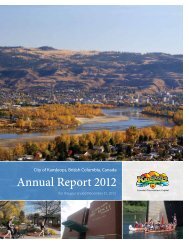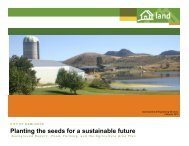GEOTOUR GUIDE - City of Kamloops
GEOTOUR GUIDE - City of Kamloops
GEOTOUR GUIDE - City of Kamloops
You also want an ePaper? Increase the reach of your titles
YUMPU automatically turns print PDFs into web optimized ePapers that Google loves.
(sTop 10) lafarGe limesTone quarry<br />
& CemenT planT, easT <strong>Kamloops</strong>:<br />
viTal earTh resourCe & Greenhouse Gas ChallenGe<br />
Figure 45. Lafarge cement plant (centre background) along the South Thompson River east <strong>of</strong> <strong>Kamloops</strong> uses limestone mined from a nearby open pit (upper<br />
left). Cement is loaded on rail cars (lower right) for transport throughout western North America. (Photo by R. Turner)<br />
Concrete is one <strong>of</strong> the most important building materials worldwide, essential for buildings, bridges, dams, and many roads.<br />
Cement is the mineral glue that holds concrete together. A large cement plant is visible from Highway 1 east <strong>of</strong> <strong>Kamloops</strong> on the<br />
north shore <strong>of</strong> the South Thompson River. The cement plant mines limestone, the major ingredient <strong>of</strong> cement, from an adjacent<br />
quarry. Cement is manufactured by grinding and heating the limestone, along with clay or shale, iron, and sand in a rotating<br />
kiln at temperatures <strong>of</strong> up to 1500 degrees Celsius. The calcium, aluminum, silicon, and iron combine to form a “clinker” while<br />
producing carbon dioxide, a “greenhouse gas”. The clinker is ground-up to form Portland cement, and gypsum is added to<br />
regulate the setting time <strong>of</strong> the cement.<br />
Most <strong>of</strong> the raw materials used in the <strong>Kamloops</strong> plant, with the<br />
exception <strong>of</strong> energy, are produced locally. Limestone comes from the<br />
quarry behind the cement plant. Alumina-silica rocks are mined at<br />
the Buse Lake quarry near Barnhartvale and the Decor quarry near<br />
Hat Creek, and gypsum is quarried near Falkland.<br />
Geologists interpret that the hill <strong>of</strong> limestone behind the cement<br />
plant formed on an ancient seafloor 270 million years ago as<br />
deposits <strong>of</strong> lime shells <strong>of</strong> microscopic marine animals and plants.<br />
These plants and animals extracted carbon dioxide dissolved in<br />
ocean water to form their shells. As the shells <strong>of</strong> dead organisms<br />
accumulated on the seafloor, the increasing pressure from continued<br />
burial slowly converted the shells to limestone rock. Today the<br />
limestone represents a vast storehouse <strong>of</strong> carbon. When limestone<br />
is heated to make cement, carbon dioxide, a major greenhouse gas,<br />
is released back into the atmosphere. Research continues to look for<br />
ways to reduce the carbon dioxide in the exhaust gases <strong>of</strong> cement<br />
production so that it does not return to the atmosphere.<br />
go taKe a looK: Drive east from <strong>Kamloops</strong> on Highway 1 about 15 km to Campbell Creek. Exit onto Dallas<br />
Drive, turn north and cross the highway overpass, rail lines, and bridge over the South Thompson River to the Lafarge<br />
cement plant. Tours <strong>of</strong> the cement plant may be arranged in advance.<br />
26<br />
Figure 46. A tiny fusilinid fossil about the size <strong>of</strong> a rice grain,<br />
as seen through a microscope. Geologists have determined that<br />
marine fossils found in the limestone are about 270 million<br />
years old and that they lived in a tropical sea. Things sure have<br />
changed! (Photo courtesy <strong>of</strong> C. Kendall)

















